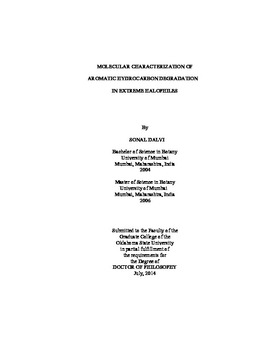| dc.contributor.advisor | Fathepure, Babu Z. | |
| dc.contributor.author | Dalvi, Sonal | |
| dc.date.accessioned | 2015-06-17T20:05:26Z | |
| dc.date.available | 2015-06-17T20:05:26Z | |
| dc.date.issued | 2014-07 | |
| dc.identifier.uri | https://hdl.handle.net/11244/14789 | |
| dc.description.abstract | Many hypersaline environments such as natural saline lakes, salt marshes, saline industrial effluents, oil fields and coastal areas are often contaminated with high levels of petroleum hydrocarbons. Since non-halophiles do not operate efficiently at high salinity, halophilic and halotolerant hydrocarbon degraders are considered as potential candidates for bioremediation of hydrocarbon-impacted hypersaline sites. Several studies have reported the ability of microbial consortia and pure cultures of halophiles and halotolerants to degrade petroleum compounds. However, information regarding the genes and mechanisms of hydrocarbon degradation pathways at high salinity is scarce. This work describes the metabolic potential of halophilic bacteria and archaea to degrade aromatic hydrocarbons at high salinity. A combination of omics-based approaches was used to study the molecular basis of hydrocarbon degradation in Arhodomonas sp. strain Seminole and Arhodomonassp. strain Rozel. Genomic analysis of strain Seminole predicted clusters of genes encoding enzymes involved in the metabolism of benzene, toluene, 4-hydroxybenzoic acid and phenylacetic acid to Krebs cycle intermediates. Many key enzymes of the predicted steps were identified in the cytosolic proteomes of hydrocarbon-grown cells by liquid chromatography-mass spectrometry, thus confirming the genomic data. Although these proteins have been described in non-halophiles, they differed from their non-halophilic homologs by exhibiting low-pI values, a unique feature known to maintain the stability and activity of halophilic proteins at high salinities. In addition, another aim of this project was to study the degradation potential of archaea in the presence of high salt. A highly enriched culture developed using sediment samples from Rozel Point; Great Salt Lake utilized benzoate as the growth substrate at salinity ranging from 2 to 5 M NaCl with highest rate of degradation at 4 M. Pyrosequencing of 16S rRNA gene sequences revealed that the enrichment composed solely of Halobacteriaceae members. Of these, Halopenitus was the most dominant member comprising of 91% of the enrichment. PCR amplification with degenerate primers revealed the presence of 4-hydroxybenzoate 3-monooxygenase and protocatechuate 3,4-dioxygenase genes, suggesting that the enrichment might degrade benzoate via protocatechuate. These results suggest the potential role of Halopenitus members in degrading oxygenated aromatic compounds at high salinity. | |
| dc.format | application/pdf | |
| dc.language | en_US | |
| dc.rights | Copyright is held by the author who has granted the Oklahoma State University Library the non-exclusive right to share this material in its institutional repository. Contact Digital Library Services at lib-dls@okstate.edu or 405-744-9161 for the permission policy on the use, reproduction or distribution of this material. | |
| dc.title | Molecular characterization of aromatic hydrocarbon degradation in extreme halophiles | |
| dc.contributor.committeeMember | Elshahed, Mostafa S. | |
| dc.contributor.committeeMember | Hadwiger, Jeffrey A. | |
| dc.contributor.committeeMember | Patrauchan, Marianna A. | |
| dc.contributor.committeeMember | DeSilva, Udaya | |
| osu.filename | Dalvi_okstate_0664D_13572.pdf | |
| osu.accesstype | Open Access | |
| dc.type.genre | Dissertation | |
| dc.type.material | Text | |
| dc.subject.keywords | aromatic hydrocarbon degradation | |
| dc.subject.keywords | genomics | |
| dc.subject.keywords | halophiles | |
| dc.subject.keywords | pathways | |
| dc.subject.keywords | proteomics | |
| thesis.degree.discipline | Microbiology and Molecular Genetics | |
| thesis.degree.grantor | Oklahoma State University | |
